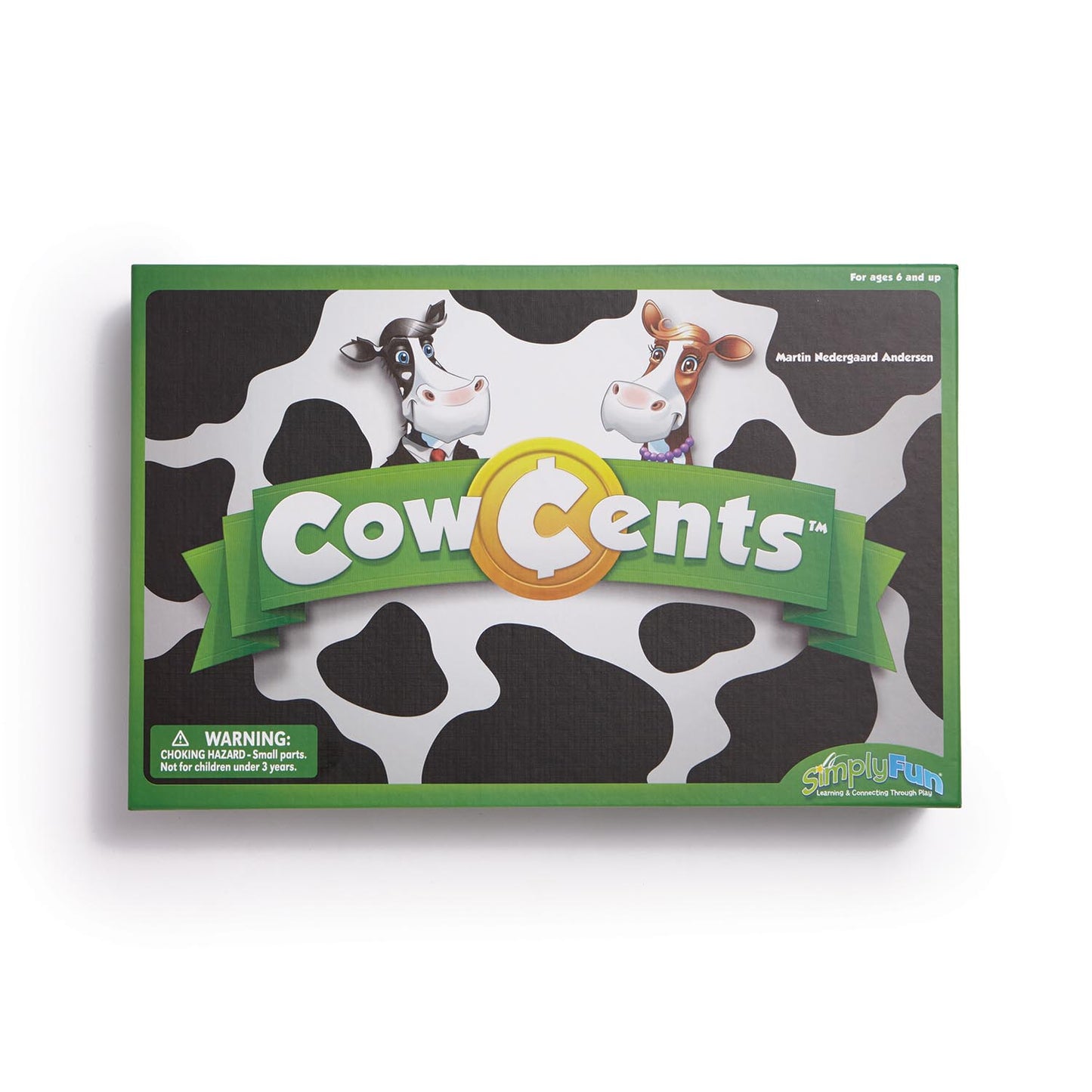
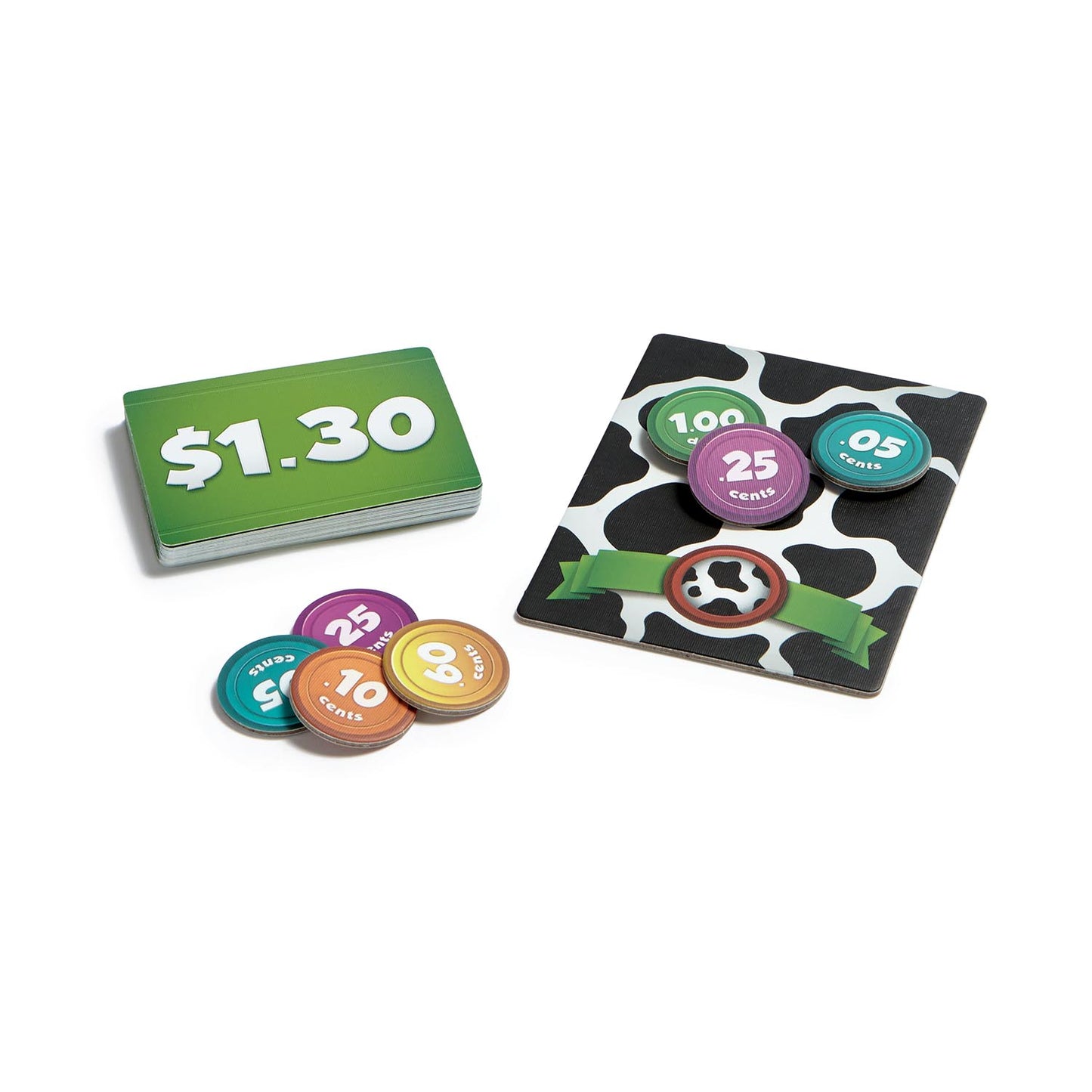
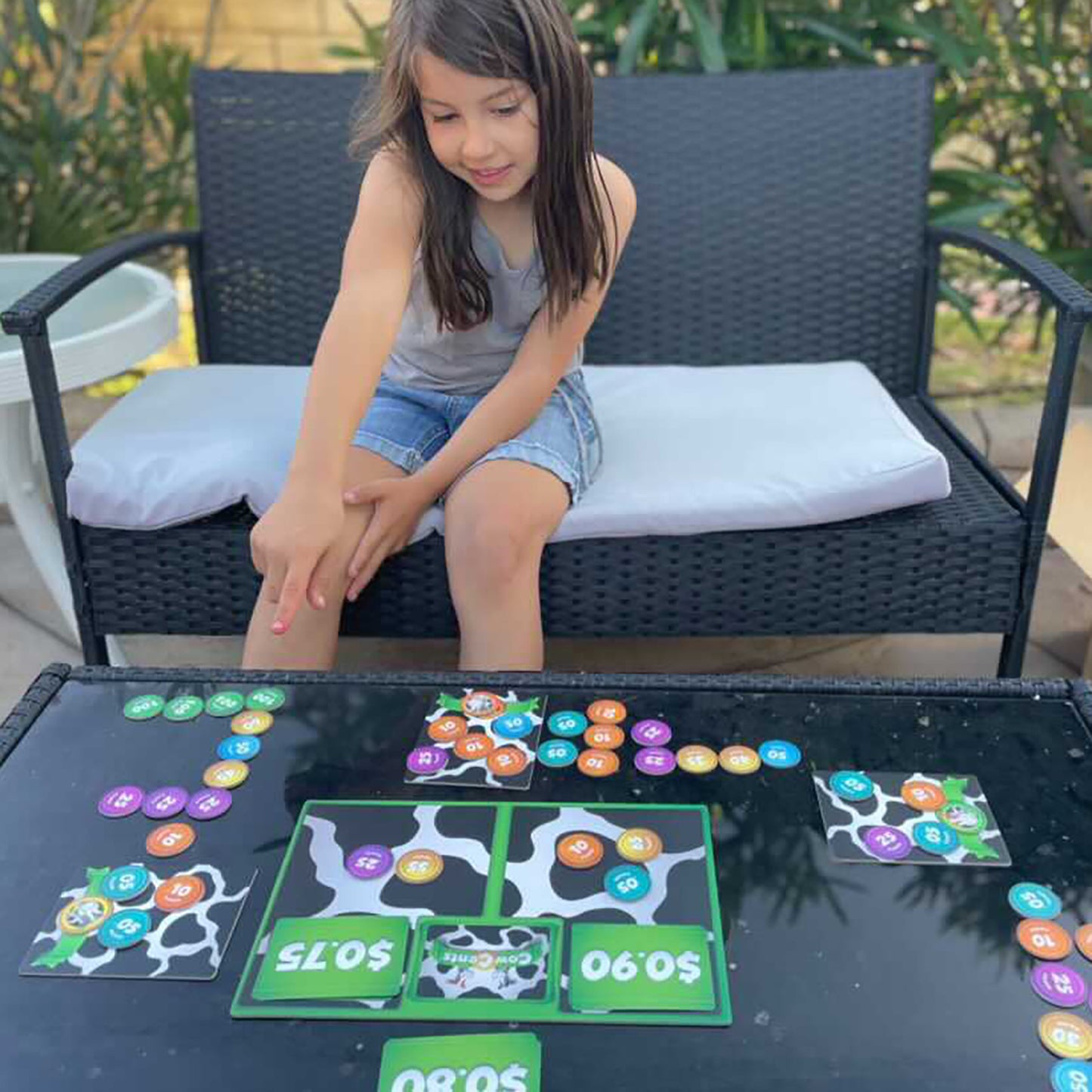
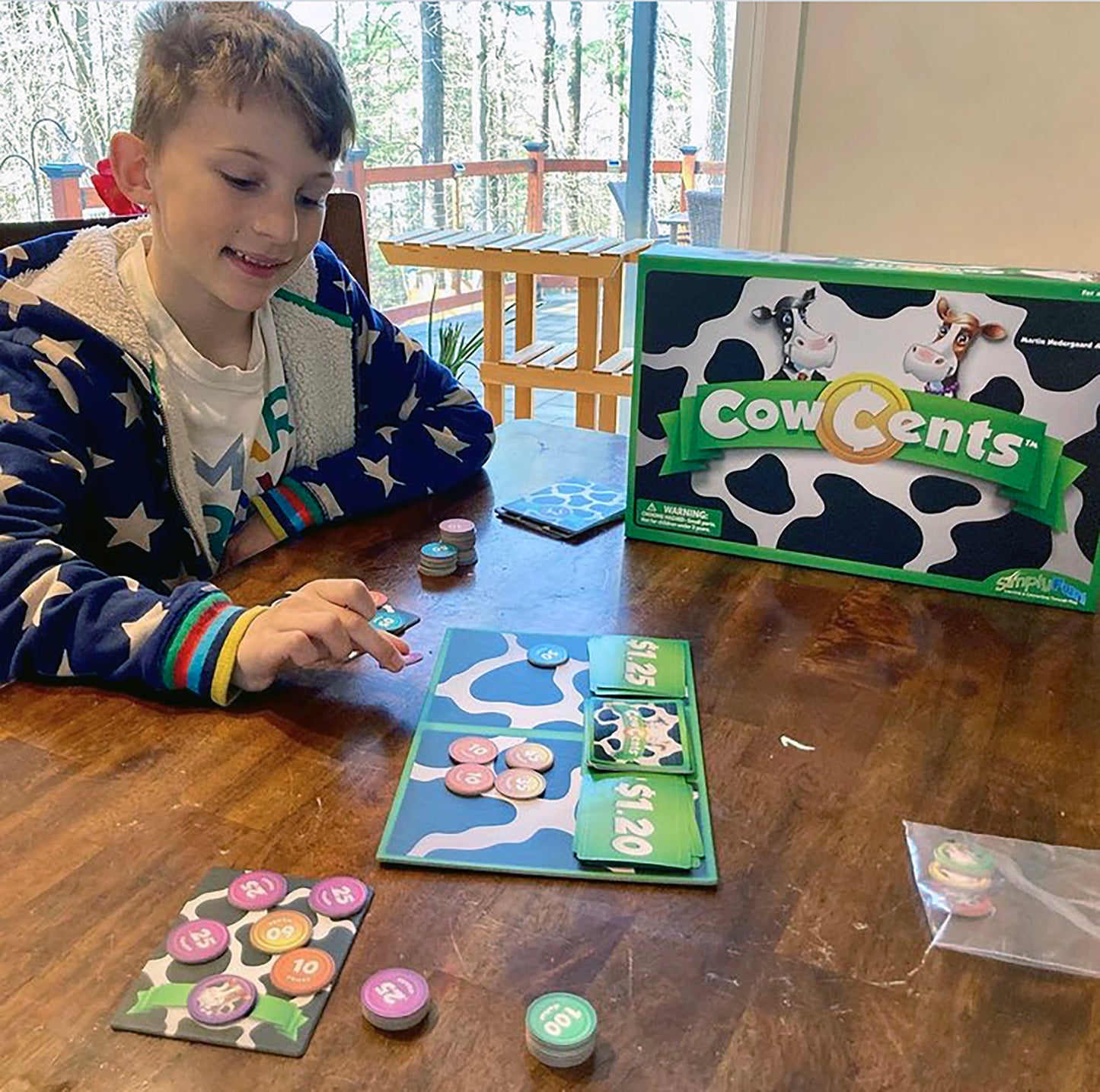
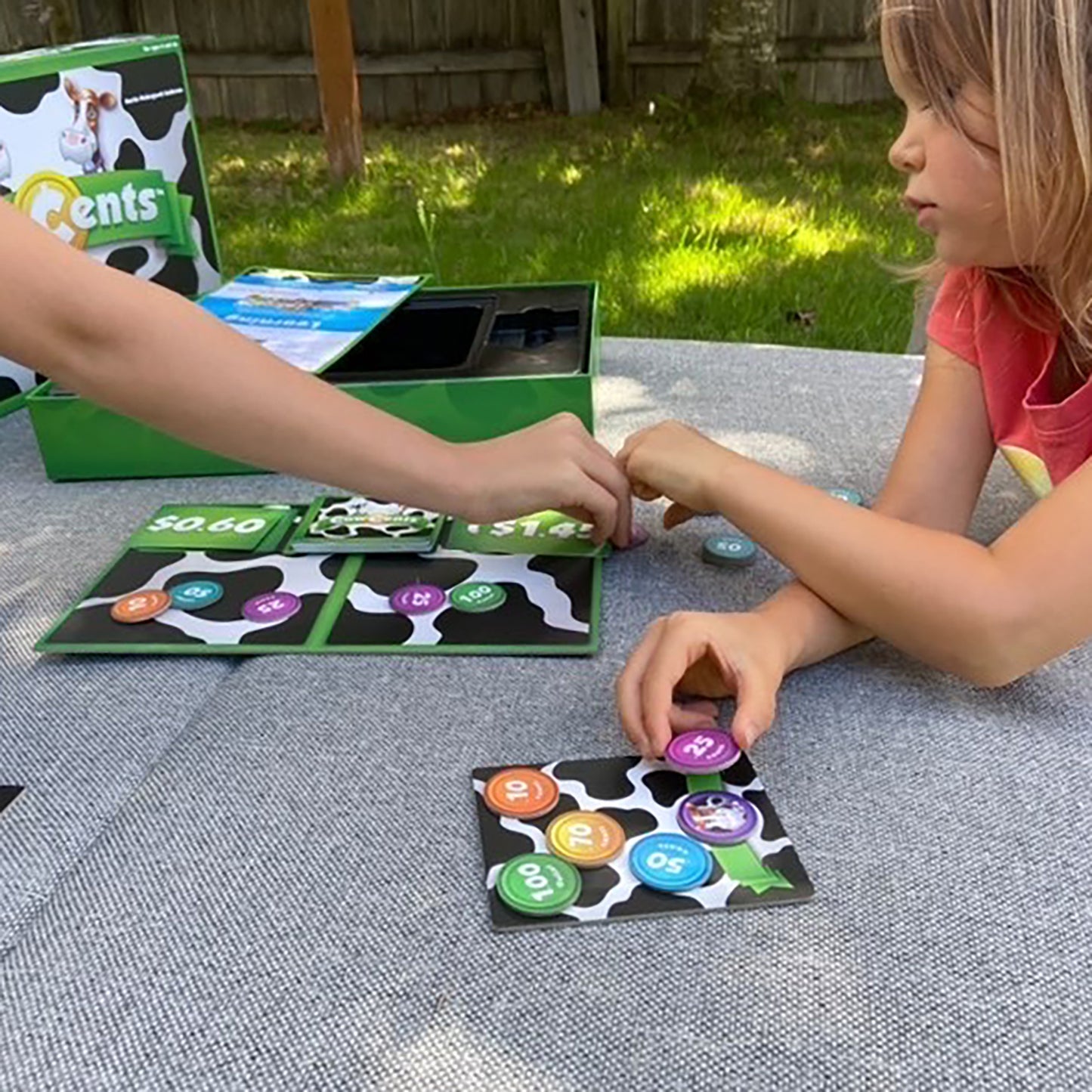

Collapsible content
In this session, we’ll learn how to play Cow Cents, where you make change to earn money.
Cow Cents is a fun way to expand understanding of monetary coin values for kids. Players try to exactly match amounts on the game board and collect the money in the pool if they succeed. Both planning and strategy are required to win the pool and avoid sharing the pot with the other players if you go over.
Set your financial goals, count your change carefully and match amounts on the goal board. The player with the most “moo”-lah at the end of the game wins.
Cow Cents can be played with 2 to 6 players, ages 6 and up.
Inside every Cow Cents box you’ll find One goal board, on which you will place a deck of Twenty four shuffled goal cards.
You’ll also find Six colored player boards and Six colored cow tokens. Each player in the game gets a board and a set of tokens in matching colors.
There are Seventy money tokens of varying denominations in Cow Cents, and, after the correct number of “coins” are distributed to each player, the remaining tokens go into the handy money bag shown here.
Cow Cents is ideal for building basic math skills as well as financial awareness. By adding and subtracting multiple combinations and denominations, young players reinforce their understanding of coin monetary values and learn adaptive strategies and decision making in the process!
Place the goal board in the center of the table so all players can reach it and distribute the individual boards and tokens.
Shuffle the goal cards and place them face down on the goal board in the marked spot. Flip over the top two cards and place them on the spaces marked “goal.” Then give each player a five, ten, twenty-five and fifty cent money token to put on his own player board. Place the remaining money tokens into the money bag. Players will take turns drawing one more token from the bag to add to their other money tokens.
All players should have a total of 5 money tokens, one player board and one cow token to begin the game.
The player with the most REAL money in his pocket starts the game by placing a money token from his player board into one of the two money pools associated with the goal cards. He then draws a new money token from the money bag. Players should have 5 money tokens on their player boards at all times.
Play continues in a clockwise direction, with each player placing a money token in the pool (and drawing a replacement token from the bag) UNTIL either the goal card is matched or exceeded OR the money pool for a card is bought by one of the players. We’ll discuss that option a little later. For now, let’s talk about what happens when the goal card is matched or exceeded.
If a player’s money token brings the total of the money in the pool to the EXACT AMOUNT on the associated goal card, that player gets to collect all the money tokens from that pool, including the token he just played, and set them aside. These collected tokens are now “out of play” and will count toward that player’s final total at the end of the game. A new goal card for that money pool is then flipped over and play continues.
Now. If a player’s money token brings the total value of the money in the pool to an amount EXCEEDING that on the goal card, he has to distribute the money tokens in that pool to the OTHER PLAYERS in the game, giving one to each player. If there are more tokens than players, the remaining tokens are put back in the money bag for continued play. As for the ones distributed to the other players, those tokens are also now out of play, but, of course, they count for the other players totals now.
Note that the player distributing the money tokens may CHOOSE which tokens to give to which players. The smart “distributor” will give the higher denominations to the players with lower totals, so as to attempt to ensure his own game-winning high total.
After distribution and replacement of tokens into the money bag, a new goal card is flipped over and play resumes.
So. What about buying a money pool?? If a player doesn’t want to wait to match a goal card, OR he wants to avoid exceeding the amount on his turn, he may choose to use his Cow Token to purchase and collect the money tokens in the pool. A cow token is the only way to purchase a money pool. The player who does so can set those tokens aside, again, adding to his total.
Since he has not used a money token on that turn, he does not need to draw another one from the bag.
Note that players can use their cow tokens only ONCE in a game. Once cow tokens are used, they must be set aside. Cow tokens also do not have a monetary value and do not count in a player’s final total.
The game ends when the last money token is drawn from the money bag. At this point, players calculate the value of all money tokens they have collected during the game. The player with the highest total wins.
Note that money tokens left on the player boards or game boards cannot be used to count toward final totals. Only those tokens that were collected or bought can count.
With Simply Fun’s Cow Cents, play your tokens wisely, and you’ll end with a whole lot of “moo-lah!”


Core Standard*: Math
Math
- Operations and Algebraic Thinking
- Add and subtract within 20. Grade Levels 1st, 2nd
- Number & Operations in Base 10
- Understand place value. Grade Levels 1st, 2nd
- Use place value understanding and properties of operations to add and subtract. Grade Levels 1st, 2nd


Explore
What Does Child Do To Use Skill In The Game?
When playing Cow Cents, Players need to consistently explore both the Goal Board and other Player Boards.
How Parents Can Assist Learning
To be successful in Cow Cents, children need to make decisions based on what is visible on the Goal Board and the Player Boards, as well as thinking about how much money other players have accumulated. Help children by asking them to "Wait. Look. Think." This will help with impulsivity, considering options and looking closely. Also, using such cues can give children a model for future play.
Learning Implications and Educator Support
To be successful in Cow Cents, children need to make decisions based on what is visible on the Goal Board and the Player Boards, as well as thinking about how much money other players have accumulated. Help children by asking them to "Wait. Look. Think." This will help with impulsivity, considering options and looking closely. Also, using such cues can give children a model for future play.
Determine
What Does Child Do To Use Skill In The Game?
Players need to determine whether to play a Money or Cow Token; and if they are going to play a Money Token, they need to decide which amount to play and where to place the Money Token on the Goal Board.
How Parents Can Assist Learning
Parents can help children decide what Money Token to play by asking questions such as, "Do you have a Money Token that will let you add up to the exact amount on a Goal Card?" or "Can you add a Money Token that does not set up another player to add one of their Tokens to equal a Goal Card?" or "Might it be better to play a high Money Token that will exceed a Goal Card so that you can prevent other players from getting all the money?"
Learning Implications and Educator Support
Determining whether to play a Money Token or Cow Token, or to play a specific Money Token requires children to consider multiple options. This is great for helping develop strategic thinking and risk-reward analysis. Educators can help children decide what Money Token to play by asking questions such as, "Do you have a Money Token that will let you add up to the exact amount on a Goal Card?" or "Can you add a Money Token that does not set up another player to add one of their Tokens to equal a Goal Card?" or "Might it be better to play a high Money Token that will exceed a Goal Card so that you can prevent other players from getting all the money?"
Compare
What Does Child Do To Use Skill In The Game?
Players need to compare in several ways, including, how much more money is needed in each Money Pool relative to the Player's Money Tokens; other Players' Money Tokens relative to their own; and the total amount of Money each Player is accumulating.
How Parents Can Assist Learning
Parents can help children take into consideration the different variables by pointing out their options. For example, "See how other players have a Money Token that will let them match the Goal Card? What can you do to prevent that?" or "Would now be a good time to play your Cow Token?"
Learning Implications and Educator Support
Comparing in Cow Cents helps children learn situational and risk-reward analysis because they need to consider and compare the consequences of a play based on the Tokens on the Goal Board and Player Boards, which Tokens are changing each turn. Educators can help children take into consideration the different variables by pointing out their options. For example, "See how other players have a Money Token that will let them match the Goal Card? What can you do to prevent that?" or "Would now be a good time to play your Cow Token?"
Remember
What Does Child Do To Use Skill In The Game?
It is helpful is a Player can remember how much money value their opponents are accumulating. They also need to remember addition and place value rules.
How Parents Can Assist Learning
It can be challenging to remember how much each player has accumulated. As an alternative, suggest to children that they count all the Tokens each opponent has. The higher the number, likely, the higher the total value the player has. Additionally, suggest that children pay special attention to the large value Money Tokens, such as everything above $0.75, that other players collect. Children may find it easier to just remember who is getting the big value Money Tokens.
Learning Implications and Educator Support
It can be challenging to remember how much each player has accumulated. As an alternative, suggest to children that they count all the Tokens each opponent has. The higher the number, likely, the higher the total value the player has. Additionally, suggest that children pay special attention to the large value Money Tokens, such as everything above $0.75, that other players collect. Children may find it easier to just remember who is getting the big value Money Tokens.
Predict
What Does Child Do To Use Skill In The Game?
This is one of the skills used most by Cow Cents Players as they try to anticipate what opponents will do on their turns.
How Parents Can Assist Learning
Cow Cents is very good for learning strategic thinking. Strategies are built based on identifying numerous options and the risk-reward for each option. Additionally, players can decide to be more offensive (i.e. gaining Money Tokens) or defensive (i.e. preventing opponents from gaining Money Tokens), and change these approaches throughout the game. To help children predict, ask them to share different moves they are considering and what they think an opponent might do in response. This requires playing non-competitively for the purpose of learning.
Learning Implications and Educator Support
Cow Cents is very good for learning strategic thinking which requires predicting. Predicting involves skills like analysis, observation, empathy and interpretation. Also, children need to learn how to change perspective, imagining being their opponent, in order to have optimal predicting skills. Educators can prompt children to practice predicting by asking them to share what opportunities they see on the Goal Board relative to opponents' Player Board, different moves they are considering and what they think an opponent might do in response.
Plan
What Does Child Do To Use Skill In The Game?
Players place their Money Tokens in a way to set themselves up on later turns to meet an amount on the Goal Card or prevent other Players from doing the same.
How Parents Can Assist Learning
To facilitate planning and organization, encourage children to "Wait. Look. Think." This will help them spend time considering different moves and the consequences of those moves, which is needed for comparing and prioritizing move options , i.e. planning their moves. This will also help with impulsivity. Using such verbal cues can give children a model for approaching future play.
Learning Implications and Educator Support
Planning is an important skill for developing strategic thinking, persistence and reaching a goal. Educators can encourage the children to discuss how they might may approach the game offensively or defensively, and the implications of either approach. Additionally encourage children to "Wait. Look. Think." This will help them spend time considering different moves and the consequences of those moves, which is needed for making comparisons of move options. This will also help with impulsivity and planning. Using such verbal cues can give children a model for approaching future play.
Practice
What Does Child Do To Use Skill In The Game?
Players are practicing addition, subtraction and strategic planning on each turn.
How Parents Can Assist Learning
If you notice children are not identifying all of their options or playing Money Tokens in a non-strategic way, probe into their thinking and decision-making. Perhaps they need support in addition or subtraction, or in identifying, examining and prioritizing the consequences of the top options they have.
Learning Implications and Educator Support
If you notice children are not identifying all of their options or playing Money Tokens in a non-strategic way, probe into their thinking and decision-making. Perhaps they need support in addition or subtraction, or in identifying, examining and prioritizing the consequences of the top options they have. To enhance the academic value of the game, every time a new Goal Card is turned face up, use dollars and cents to add up the value shown on the Card. This will allow children to learn about money as well as mathematics.
Solve
What Does Child Do To Use Skill In The Game?
Based on the moves of their opponents, a Player tries to make a winning move on each turn. Winning moves can be matching the exact amount on a Goal Card, intentionally exceeding the amount to prevent someone else from getting all the Money Tokens, or playing their only Cow Token at the right time.
How Parents Can Assist Learning
No special parent support required. However, it may be helpful to discuss how a child decided to play a token on their turn. This can help the child and other players learn how to observe closely, attend to others and think strategically, as well as to learn addition and subtraction.
Learning Implications and Educator Support
No special educator support required. However, it may be helpful to discuss how a child decided to play a token on their turn. This can help the child and other players learn how to observe closely, attend to others and think strategically, as well as to learn addition and subtraction.
Review
What Does Child Do To Use Skill In The Game?
Players may review if encouraged. See How Parents Can Assist Learning, and Learning Implications and Educator Support.
How Parents Can Assist Learning
Reviewing previous actions is important for learning. Parents can ask children to think about what they did before. "What do you need to think about?" "Why did that work so well?" "Tell us how you did that?"
Learning Implications and Educator Support
Reviewing previous actions is important for learning. Educators can ask children to think about what they did before. "What do you need to think about?" "Why did that work so well?" "Tell us how you did that?"
Demonstrate
What Does Child Do To Use Skill In The Game?
Players may review if encouraged. See How Parents Can Assist Learning, and Learning Implications and Educator Support.
How Parents Can Assist Learning
Although not required in the game, parents can help children practice and formulate a deeper understanding of mathematical principles and strategic thinking by asking them to demonstrate or explain their thinking. Parents can also share their model strategic thinking by explaining and demonstrating how they made a winning move or set themselves up to match the exact Goal Card amount on a later turn.
Learning Implications and Educator Support
in the game, parents can help children practice and formulate a deeper understanding of mathematical principles and strategic thinking by asking them to demonstrate or explain their thinking. Parents can also share their model strategic thinking by explaining and demonstrating how they made a winning move or set themselves up to match the exact Goal Card amount on a later turn. Although not required in the game, educators can help children practice and formulate a deeper understanding of mathematical principles and strategic thinking by asking them to demonstrate or explain their thinking.
*Data compiled from CCSSI ELA Standards, WA Science Standards, and Washington Social Studies Standards


Cognitive
Suggestions for How to Modify Play Experience
Remove all Goal Cards over $1.00 to make the game easier.
To practice counting by 10's use just the numbers ending in 0. This is also an easier version of the game.
Communication
Suggestions for How to Modify Play Experience
Talk about what you can buy with the amount of money on the Goal Card. What would you want to buy? How much would what you want cost? This will give the players an opportunity to talk and also an idea of what items actually cost in real life.
For children who have difficulty with communication, choral counting may be helpful. Whenever a coin is placed in a money pool, all players can count the amount in that pool together. The player who laid the coin leads the counting by touching each coin as it is counted.
Sensorimotor
Suggestions for How to Modify Play Experience
Money Tokens are fairly thick, so children should be able to pick them up. Placement can be anywhere on the Money Pool area. Cards can be turned over by another player if needed.
Social Emotional/Behavioral
Suggestions for How to Modify Play Experience
To give children more chances to succeed, add two more Goal Cards to the outside of the bottom of the Goal Board. This give children two more choices for pools and two more chances to use their money to meet a goal.
Children who have difficulty with math may get easily frustrated if they can't add the Money Tokens. Make a number line on a piece of paper from 0 to $2.00 with equally-spaced marks for every 5 cents. Write 5¢, 10¢, 15¢, 20¢, 25¢, etc. on the marks on the line. Use the line to help children figure out how much money is in the money pool. Every time a Money Token is added, they can "count on" from the amount they have on the number line to find the new total. Similarly, they can use the number line to determine the sum of adding any of their Money Tokens to the Money Pool.
Vision
Suggestions for How to Modify Play Experience
Green and purple Money Tokens have the most contrast from number to background. Give children with low vision these Money Tokens.
Allow children with low vision to use a magnifying glass to look at the Money Tokens and Goal Cards.
Hearing
Suggestions for How to Modify Play Experience
Cow Cents does not require communication or listening. Use sign, if possible, to encourage communication.
*Data compiled from CCSSI ELA Standards, WA Science Standards, and Washington Social Studies Standards


Autism Strengths & Interests
Short Summary of Strengths & Interests
- Like to play with or use money.
- Is good at simple addition and subtraction.
- Is good at patterning and sequencing numbers.
Is good at matching visual items
Is This Game Appropriate? Yes
Description
Players need to match amounts rather make a visual match. They draw a total amount goal card, then need to determine which of their amount coins can add up to this total. If the child is good at addition, this game will build on this strength
Has a good memory for sensory details, including visual, touch, taste and smell
This game is not appropriate
Has a good memory for words, phrases and dialouge
This game is not appropriate
Has a good memory for pictures, numbers and patterns
Is This Game Appropriate? Yes
Description
Children who can add using a pattern, such as adding by 5's, 10's, etc. have an advantage over children who are using conventional addition methods. Children with autism are often good at seeing patterns and quickly determining an answer, for example, 10 + 10 + 5 is obtained by counting 10, 20, 25.
Likes to put things in order or a sequence
Is This Game Appropriate? Yes
Description
Using a sequential strategy is a common method for children who are good at math. In Cow Cents the players may use a strategy of adding on to the largest number, then adding by 10's and then 5's. Adding in a logical sequence also helps the player determine amounts the other players have obtained.
Learns through visualizing or "replaying" actions in their mind
This game is not appropriate
Likes activities with rules, such as math and phonics
Is This Game Appropriate? Yes
Description
Cow Cents involves both math and money concepts, both of which follow clear rules. Children with autism who like to follow rules, especially mathematics, will enjoy using their adding, comparing and sequencing skills to play the game.
Is very concrete and literal
This game is not appropriate
Learns in small "chunks" (for example, phone numbers are 3 chunks of number xxx-xxx-xxxx that are combined together)
This game is not appropriate
Is good at nonverbal reasoning and logic
Is This Game Appropriate? Yes
Description
Reasoning with numbers involves understanding patterns and applying logic to the numbers provided to obtain an answer. Children with autism who enjoy math or other pattern-based activities may be good at visualizing the options and seeing patterns, such as adding by 5's or 10's. Cow Cents also involves observing the scores of other players. If a player exceeds the Goal Card amount, the player then uses logical reasoning to give the smallest value coins to others players with the higher current total scores, and vice versa. Thus, children who are good at determining and prioritizing multiple values will be able to hone those skills in Cow Cents.
Likes spatial problem solving
This game is not appropriate
Can read well with good vocabulary, though may not fully comprehend content
This game is not appropriate
Likes to use and has good fine motor skill
This game is not appropriate
Likes established routines or set ways of doing things
This game is not appropriate
Likes manipulating, constructing or building things
Is This Game Appropriate? Yes
Description
Likes to use and has good musical abilities
This game is not appropriate
Likes to use and has good drawing skills
This game is not appropriate
Autism Special Considerations
Appears to ignore other's communication and/or has difficulty giving eye contact to a communication partner
Is This Game Appropriate for Child with Characteristic? Yes
Can Child with Characteristic Play Game w/o Modification? Yes
Strategies for Developing Compensatory Skills:
Cow Sense does not require eye contact with other players. Players are likely to say what they are doing and comment on the play. Encourage the child to watch others and "help" them add.
Has difficulty understanding complex verbal directions
Is This Game Appropriate for Child with Characteristic? Yes
Can Child with Characteristic Play Game w/o Modification? Yes
Strategies for Developing Compensatory Skills:
The directions are not complex, so as long as the child can do addition, the game should work. Make sure examples are provided in as step-by-step way to illustrate the directions.
Uses vocabulary inaccurately or demonstrates echolalia (repeating another's speech)
Is This Game Appropriate for Child with Characteristic? Yes
Can Child with Characteristic Play Game w/o Modification? No
Strategies for Developing Compensatory Skills:
Echolalia or off-topic discussions may be distracting to other players. Involve the child by having the child add up the Money Tokens in the Money Pool with each turn. This may help keep the child on topic.
Gets stuck repeating a verbal topic or physical actions and/or has difficulty attending to others' actions or topic.
Is This Game Appropriate for Child with Characteristic? Yes
Can Child with Characteristic Play Game w/o Modification? No
Strategies for Developing Compensatory Skills:
Whenever a Money Token is placed in a Money Pool, all players can count the amount in that pool together. The player who laid the Money Token leads the counting by touching each Money Token as it is counted. Tell the child to watch the players' finger and help him count. A fidget toy or frequent breaks for a preferred motor activity may help.
Has difficulty producing speech/communication
Is This Game Appropriate for Child with Characteristic? Yes
Can Child with Characteristic Play Game w/o Modification? No
Strategies for Developing Compensatory Skills:
If the child is good at addition, the game may hold their attention. If this is the case, communication is not needed, as the child can add the Money Tokens and hold up the Goal Card when the goal is achieved.
Has difficulty sequencing multi-step actions and/or doing complex abstract tasks
Is This Game Appropriate for Child with Characteristic? Yes
Can Child with Characteristic Play Game w/o Modification? No
Strategies for Developing Compensatory Skills:
Addition of money requires manipulating numbers mentally. Some children with autism are good at this, while others not. If math is a preferred activity, the game will not be frustrating; however, if addition is challenging, the child may quickly lose interest and begin avoidance behaviors. The use of the Cow Token requires that the child understand when and how it can be used. If this is too confusing, omit this token.
Demonstrates difficulty initiating and maintaining social interactions
Is This Game Appropriate for Child with Characteristic? Yes
Can Child with Characteristic Play Game w/o Modification? Yes
Strategies for Developing Compensatory Skills:
Social interaction is not needed to play the game, although the children need to know when it is their turn. Encourage social interaction by talking about what each player would buy with the money.
Acts out or demonstrates avoidance behaviors when frustrated, overwhelmed, or needs more sensory input.
Is This Game Appropriate for Child with Characteristic? Yes
Can Child with Characteristic Play Game w/o Modification? No
Strategies for Developing Compensatory Skills:
Addition of money requires manipulating numbers mentally. Some children with autism are good at this, while others not. If math is a preferred activity, the game will not be frustrating; however, if addition is challenging, the child may quickly lose interest and begin avoidance behaviors. Modify the game by using only the smaller Money Tokens and the lower amount Goal Cards. As the child acquires skill, add in higher amounts.
Has short attention span for non-preferred activities
Is This Game Appropriate for Child with Characteristic? Yes
Can Child with Characteristic Play Game w/o Modification? No
Strategies for Developing Compensatory Skills:
If math is a preferred activity, the game will work well. If math is not a preferred activity provide a reinforcement of a fruit or activity the child likes when the Goal Card is earned. For example, when a Goal Card is turned over, say, "Two grapes will cost you 60¢." or "$1.35 will earn you four pulls on the stretchy band."
Needs sameness or consistent routines and/or has difficulty with transitions from one activity to another
Is This Game Appropriate for Child with Characteristic? Yes
Can Child with Characteristic Play Game w/o Modification? No
Strategies for Developing Compensatory Skills:
The game is played in the same way with each turn, so it is predictable once the child has played several turns. To get the child interested in playing the game, let them explore the Money Tokens and arrange them on the table in a pattern before letting the child put them in the bag. Having some control over the materials helps with transitions.
Has difficulty understanding others' feelings, intentions, and the reasons for others' actions.
Is This Game Appropriate for Child with Characteristic? Yes
Can Child with Characteristic Play Game w/o Modification? Yes
Strategies for Developing Compensatory Skills:
The game does not require understanding others' feelings or intentions.
*Data compiled from CCSSI ELA Standards, WA Science Standards, and Washington Social Studies Standards


Extra Ways to Play the Game
Parents can create a buying activity using the Money Tokens. Give each child a set amount of tokens for the day (for example, $5.00 or $10.00). Create a list of things the child can buy from food to activities to toys around the home. Make paper tags or a list of what each thing costs. Show them what everything costs so they can budget their money. During the day, children can use the tokens to buy servings of food, special time with parents, etc.
Materials Needed
List of what each item or activity costs or individual tags the children can keep.
Developmental Benefits
This modification helps children plan and prioritize how to spend money. They need to think about the whole day and what is important to them. If there are multiple children, they can compare what they want and plan activities together.
Extra Ways to Play the Game
For each Goal Card turned over, turn over an item card (see Materials Needed). When a Goal Card is matched or the money pool is purchased, the player turns over an item card. The player must then determine how many of the item on the card their money will purchase in order to claim their Money Tokens. They may use their fingers, the Money Tokens, or paper and pencil. Will any money be left over? If there is not sufficient money they can just say, "I can't buy any." If their answer is wrong, they must put the Money Tokens back into the bag. Encourage children to check their answer more than one way.
Materials Needed
Make up paper cards the size of a Goal Card. Write an item and its cost on each card. For example, draw a piece of candy for 5¢ or a small toy for 25¢.
Developmental Benefits
This modification adds a practical element to the game. Children are not just adding up money, but they are seeing how much it will buy. This is also an introduction to division and making change. Children are also practicing counting or adding equivalent amounts, which is an introduction to multiplication. The adult can reinforce these concepts with their statements. For example, "Yes. There are 4 quarters in a dollar." or "One quarter times 4 equals one dollar."
Extra Ways to Play the Game
An alternative way to play Cow Cents is change the rule regarding Exceeding the Goal Card. Instead of the existing rule, allow players to place a Money Token the causes the cummulative amount to exceed the Goal Card. On subsequent turns, players can place a Money Token to subtract from the cummulative amount in order to make the amount equal to the Goal Card. In this version, only when a player makes the Money Pool equal to the Goal Card can the player win all the tokens in that Money Pool.
Materials Needed
No extra materials.
Developmental Benefits
This variation introduces subtraction into the game, as well as new options that change the strategy children are learning.
*Data compiled from CCSSI ELA Standards, WA Science Standards, and Washington Social Studies Standards
- Choosing a selection results in a full page refresh.
- Opens in a new window.







